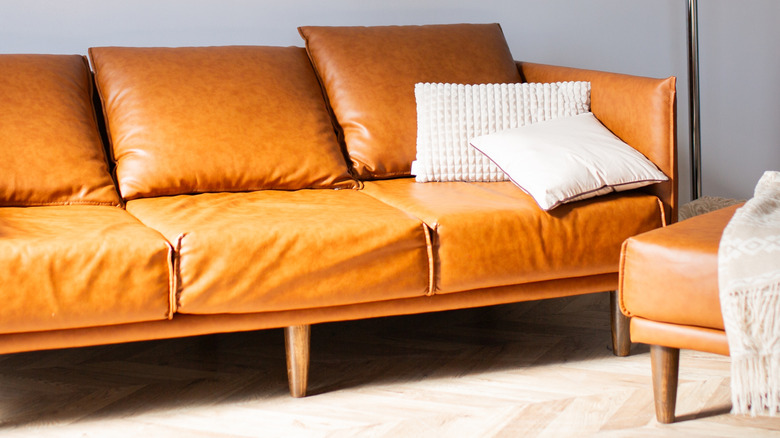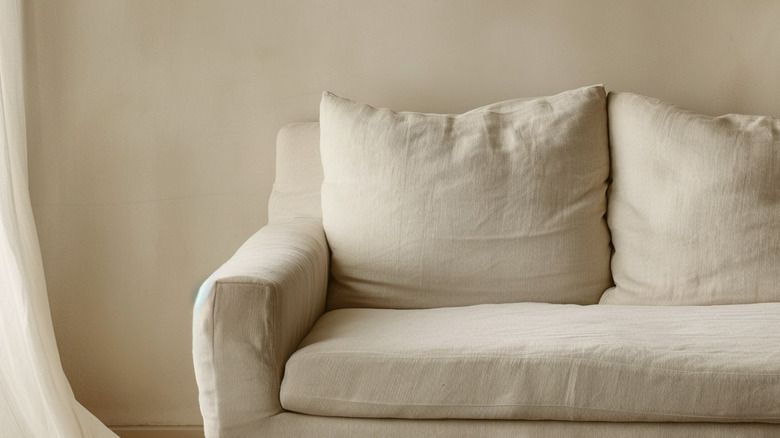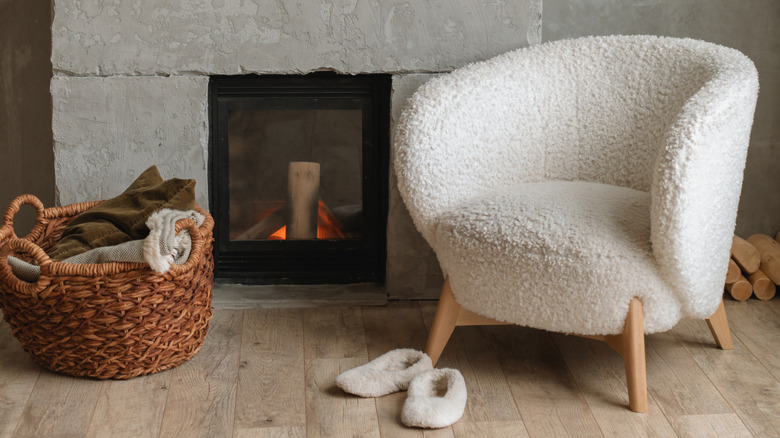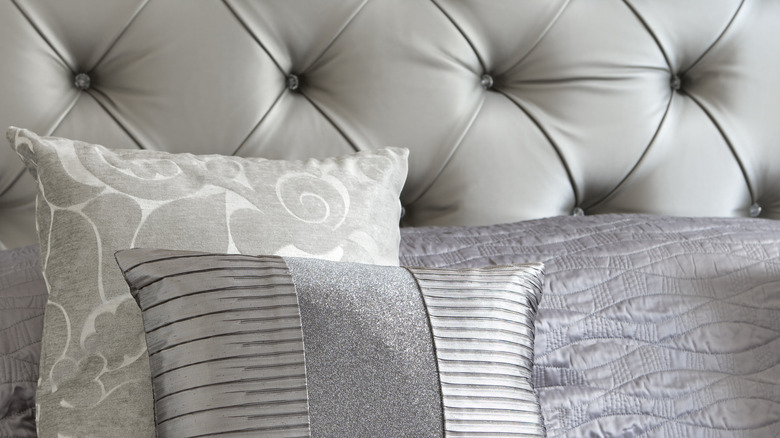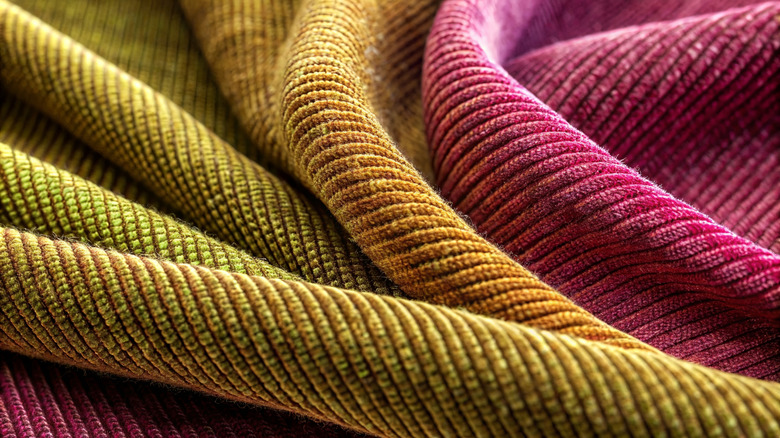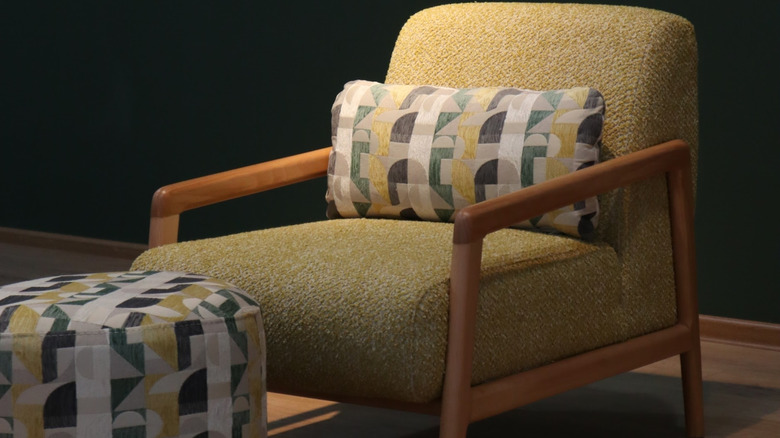8 Of The Worst Fabrics To Avoid For Longer Lasting Furniture
When it comes to choosing the right furniture pieces for your space, it can be overwhelming to sort through all the options and details to consider. Take buying a couch, for example: Do you want to go colorful or neutral? Firm or soft? Should you opt for a modular sofa or a sectional? There are a million things to think about — and considering the fact that furniture can be quite costly, it's smart to be diligent. One key detail that should never be overlooked is the type of fabric you choose for your furniture — especially if you want your pieces to stand the test of time.
While certain materials like cotton, microfiber, and leather are known for being great choices — they're durable, easy to clean, and often wear well — some are more prone to stains, pulling, or tearing, and can start to look worn much sooner than you'd like them to. Furniture made from some of these less durable fabrics may indeed be more affordable — and if you're buying something temporary that you only intend to keep for a couple of years, or you're looking for furniture to put in a low-traffic space, then it might be perfectly fine. But if you're hoping to invest in long-lasting furniture, there are some fabrics that you'll want to steer clear of. Below, we've shared a few to avoid — and why — from silk and certain types of wool to faux leather and velvet.
Faux leather
While faux leather does share some positive qualities with real leather — including its sophisticated, timeless look and the fact that it's stain-resistant and easy to clean — it comes with some drawbacks. Although it can be up to 70 percent cheaper than real leather, that lower price comes at a cost. Faux leather furniture is significantly less durable, so if you're looking for a leather sofa that will last for years, faux probably isn't the way to go. It's known to crack and peel over time — and that wear can start to show just a few months after bringing it home.
Velvet
If you're on the hunt for long-lasting furniture, you might want to steer clear of velvet fabrics — both synthetic and real. Although it can give your space an instant touch of elegance — and is a chic way to incorporate the 'French-girl style' into your home — velvet furniture doesn't have the staying power of more durable fabrics like cotton or microfiber. While it's durable in the sense that it doesn't tear easily, the surface is prone to fading and can quickly become crushed, flattened, and discolored in high-traffic rooms.
Linen
Although it's available in tight weaves to prevent pilling, linen furniture still might not be the best choice if you're looking for pieces that won't show wear. Linen fabric is known to wrinkle easily, and its naturally absorbent tendencies make it prone to stains. And to add to the challenge, its sensitivity to heat and tendency to shrink make it incredibly tricky to resolve both of those issues. And while it's naturally resistant to dust — making it a good option for people with allergies — it's certainly not resistant to dirt, and can actually reveal it quite easily.
Silk
Certainly not included on the list of sofa materials that are the easiest to clean, silk upholstered couches and chairs are actually among the hardest — and most expensive — to maintain. The fabric is so prone to stains that even something as simple as a water spill can cause permanent damage and discoloration. It's also sensitive to heat, which makes it difficult to treat stains. On top of that, silk isn't very durable and can easily rip or tear — especially if you have pets lounging on it. And because of its delicate nature, a small tear can quickly turn into a bigger problem.
Wool Boucle
One of this year's trendy furniture materials that makes cleaning way harder than it needs to be, wool-based boucle might sound like a good idea in theory — its soft texture does create a warm, inviting atmosphere. And while it has its benefits, the cozy fabric comes with some downsides, too. As an absorbent material, wool can quickly soak up spills, making it prone to stains. Plus, dust and dirt can easily get trapped in its fibers, meaning it needs regular vacuuming. And even if you stay on top of that, other factors like pilling and shedding can make the furniture look worn over time.
Viscose
The most common form of rayon, viscose fabric, is often referred to as "artificial silk" thanks to its similar drape and shine. Although not quite as delicate as silk, viscose furniture still comes with many of the same challenges — the biggest being that it's extremely susceptible to stains and water marks, both of which can permanently damage the material. Viscose can also shrink when wet, so cushion covers need extra caution when going in the wash. And because it's sensitive to harsh cleaning products, stain removal can be a pain. Even with extra care, maintaining viscose furniture can become more hassle than it's worth.
Chenille
Although its soft, velvet-like texture might make your furniture look more luxurious at first, chenille can be prone to stains and hard to clean — meaning your chenille-upholstered sofa or dining chairs might not look like luxury pieces for long. Extremely sensitive to moisture, extreme heat, and sunlight, the fabric is known for losing its color and fading unevenly (especially if exposed to direct sunlight for too long). It can also stretch out and lose its elasticity over time, creating awkward sags in the cushions. Plus, it's an especially poor choice for pet owners because its looped threads create the perfect place for claws to snag.
Tweed
Tweed furniture might have a timeless, tailored look, but it's not always the easiest fabric to maintain. Another material made from wool, though less soft and rougher in texture than boucle or sherpa wool, tweed has a similar set of challenges, as it's prone to pilling. And while it might hold up relatively well in a house without animals, people with pets should probably steer clear if they want their furniture to last. Pet hair can easily get trapped between its fibers, and while it's durable in many ways, tweed doesn't hold up well against animal claws.

